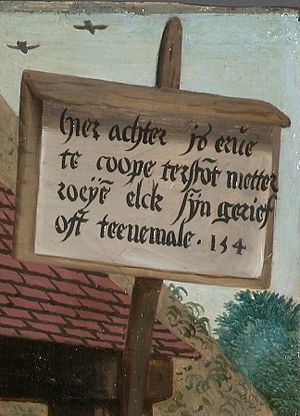History

In England, the perch was officially discouraged in favour of the rod as early as the 15th century;[8][better source needed] however, local customs maintained its use. In the 13th century perches were variously recorded in lengths of 18 feet (5.49 m), 20 feet (6.1 m), 22 feet (6.71 m) and 24 feet (7.32 m); and even as late as 1820, a House of Commons report notes lengths of 16+1⁄2 feet (5.03 m), 18 feet (5.49 m), 21 feet (6.4 m), 24 feet (7.32 m), and even 25 feet (7.62 m).[9] In Ireland, a perch was standardized at 21 feet (6.4 m), making an Irish chain, furlong and mile proportionately longer by 27.27% than the "standard" English measure.[10]
Until English King Henry VIII seized the lands of the Roman Catholic Church in 1536,[1] land measures as we now know them were essentially unknown.[1] Instead a narrative system of landmarks and lists was used. Henry wanted to raise even more funds for his wars than he'd seized directly from church property (he'd also assumed the debts of the monasteries[1]), and as James Burke writes and quotes in the book Connections that the English monk Richard Benese "produced a book on how to survey land using the simple tools of the time, a rod with cord carrying knots at certain intervals, waxed and resined against wet weather." Benese poetically described the measure of an acre in terms of a perch:[3]
an acre bothe of woodlande, also of fyldlande [heath] is always forty perches in length, and four perches in breadth, though an acre of woodlande be more in quantitie [value, i.e. was more valued commercially] than an acre of fyldelande
The practice of using surveyor's chains, and perch-length rods made into a detachable stiff chain, came about a century later when iron was a more plentiful and common material. A chain is a larger unit of length measuring 66 feet (20.1168 m), or 22 yards, or 100 links,[11] or 4 rods (20.1168 meters). There are 10 chains or 40 rods in a furlong (eighth-mile), and so 80 chains or 320 rods in one statute mile (1760 yards, 1609.344 m, 1.609344 km); the definition of which was legally set in 1593 and popularized by Royal surveyor (called the 'sworn viewer'[12]) John Ogilby only after the Great Fire of London (1666).
An acre is defined as the area of 10 square chains (that is, an area of one chain by one furlong), and derives from the shapes of new-tech plows[2] and the desire to quickly survey seized church lands into a quantity of squares for quick sales[3] by Henry VIII's agents; buyers simply wanted to know what they were buying whereas Henry was raising cash for wars against Scotland and France.[3] Consequently, the surveyor's chain and surveyor rods or poles (the perch) have been used for several centuries in Britain and in many other countries influenced by British practices such as North America and Australia. By the time of the industrial revolution and the quickening of land sales, canal and railway surveys, et al. Surveyor rods such as used by George Washington were generally made of dimensionally stable metal—semi-flexible drawn wrought iron linkable bar stock (not steel), such that the four folded elements of a chain were easily transportable through brush and branches when carried by a single man of a surveyor's crew. With a direct ratio to the length of a surveyor's chain and the sides of both an acre and a square (mile), they were common tools used by surveyors, if only to lay out a known plottable baseline in rough terrain thereafter serving as the reference line for instrumental (theodolite) triangulations.
The rod as a survey measure was standardized by Edmund Gunter in England in 1607 as a quarter of a chain (of 66 feet (20.12 m)), or 16+1⁄2 feet (5.03 m) long.
In ancient cultures
The perch (pertica) as a lineal measure in Rome (also decempeda) was 10 Roman feet (2.96 metres), and in France varied from 10 feet (perche romanie) to 22 feet (perche d'arpent—apparently 1⁄10 of "the range of an arrow"—about 220 feet). To confuse matters further, by ancient Roman definition, an arpent equalled 120 Roman feet. The related unit of square measure was the scrupulum or decempeda quadrata, equivalent to about 8.76 m2 (94.3 sq ft).[13]
In continental Europe

Units comparable to the perch, pole or rod were used in many European countries, with names that include French: perche and canne, German: Ruthe, Italian: canna and pertica, Polish: pręt and Spanish: canna. They were subdivided in many different ways, and were of many different lengths.
| Place | Local name | Local equivalent | Metric equivalent (meters) |
|---|---|---|---|
| Aachen | Feldmeßruthe | 16 Fuß | 4.512[14] |
| Amsterdam | Roede | 13 Voet | 3.681[15] |
| Aubenas, Ardèche | canne | 8 pans | 1.985[14] |
| Baden, Grand Duchy of | Ruthe | 10 Fuß | 3.0[14] |
| Basel, Canton of | Ruthe | 16 Fuß | 4.864[14] |
| Bern, Canton of | Ruthe | 10 Fuß | 2.932[14] |
| Barcelona | canna | 8 palmos | 1.581[14] |
| Braunschweig | Ruthe | 16 Fuß | 4.565[14] |
| Bremen | Ruthe | 8 Ellen or 16 Fuß | 4.626[14] |
| Brussels | Ruthe | 20 Fuß | 4.654[14] |
| Cagliari, Sardinia | canna | 10 palmi | 2.322[14] |
| Calenberg Land | Ruthe | 16 Fuß | 4.677[14] |
| Cassel, Hessen | Ruthe | 14 Fuß | 4.026[14] |
| Denmark | Ruthe | 10 Fuß | 3.138[14] |
| Canton of Geneva | Ruthe | 8 Fuß | 2.598[14] |
| Hamburg | Geestruthe | 16 Fuß | 4.583[14] |
| Hamburg | Marschruthe | 14 Fuß | 4.010[14] |
| Hannover | Ruthe | 16 Fuß | 4.671[14] |
| France | Perche | 3 toises | 5.847[14] |
| France | Perche (for woodland) | 3+2⁄3 toises | 7.145[14] |
| Genoa | canna | 10 palmi | 2.5[14] |
| Jever, Oldenburg | Ruthe | 20 Fuß | 4.377[14] |
| Mallorca | canna | 8 palmos | 1.714[14] |
| Malta | canna | 8 palmi | 2.08[14] |
| Mecklenburg | Ruthe | 16 Fuß | 4.655[14] |
| Menorca, but not Mahón | canna | 1.599[14] | |
| Menorca, city of Mahon | canna | 8 palmos | 1.714[14] |
| Messina, Sicily | canna | 8 palmi | 2.113[14] |
| Montauban, Tarn-et-Garonne | canne | 8 pans | 1.783[14] |
| Morocco | canna | 8 palmos | 1.714[14] |
| Naples | canna (for cloth) | 8 palmi | |
| Naples, Kingdom of: Apulia, Calabria, Eboli, Foggia, Lucera | percha | 7 palmi | 1.838[14] |
| Naples, Kingdom of: Capua | percha | 7+1⁄5 palmi | 1.892[14] |
| Naples, Kingdom of: Fiano, Naples | percha | 7+1⁄2 palmi | 2.014[14] |
| Naples, Kingdom of: Caggiano, Cava, Nocera, Rocce, Salerno | percha | 7+2⁄3 palmi | 1.971[14] |
| Nuremberg, Bavaria | Ruthe | 16 Fuß | 4.861[14] |
| Oldenburg | Ruthe | 20 Fuß | 5.927[14] |
| Palermo, Sicily | canna | 8 palmi | 1.942[14] |
| Parma | Pertica | 6 bracci | 3.25[14] |
| Poland | Pręt | 7+1⁄2 łokci or 10 pręcików | 4.320[14] |
| Prussia, Rheinland | Ruthe | 12 Fuß | 3.766[14] |
| Rijnland | Roede | 12 Voet | 3.767[15] |
| Rome | canna (for cloth) | 2[14] | |
| Rome | canna (for building) | 2.234[14] | |
| Saragoza | canna | 2.043[14] | |
| Saxony | Ruthe | 16 Leipziger Fuß | 4.512[14] |
| Sweden | Ruthe | 16 Fuß | 4.748[14] |
| Tortosa | canna | 1.7[14] | |
| Tuscany, Grand-Duchy of (Florence, Pisa) | canna | 5 bracci | 2.918[14] |
| Uzès, Gard | canne | 8 pans | 1.98[14] |
| Waadt, Canton of | Ruthe or toise courante | 10 Fuß | 3[14] |
| Württemberg | Reichsruthe | 10 Fuß | 2.865[14] |
| Württemberg | old Ruthe | 16 Fuß | 4.583[14] |
| Venice, Republic of | Pertica | 6 piedi | 2.084[14] |
| Zürich, Canton of | Ruthe | 10 Fuß | 3.009[14] |
In Britain and Ireland

In England, the rod or perch was first defined in law by the Composition of Yards and Perches, one of the statutes of uncertain date from the late 13th to early 14th centuries: tres pedes faciunt ulnam, quinque ulne & dimidia faciunt perticam (three feet make a yard, five and a half yards make a perch).[16]
The length of the chain was standardized in 1620 by Edmund Gunter at exactly four rods.[17][18] Fields were measured in acres, which were one chain (four rods) by one furlong (in the United Kingdom, ten chains).[19]
Bars of metal one rod long were used as standards of length when surveying land. The rod was still in use as a common unit of measurement in the mid-19th century, when Henry David Thoreau used it frequently when describing distances in his work, Walden.[20]
In traditional Scottish units, a Scottish rood (ruid in Lowland Scots, ròd in Scottish Gaelic), also fall measures 222 inches (6 ells).[21]
